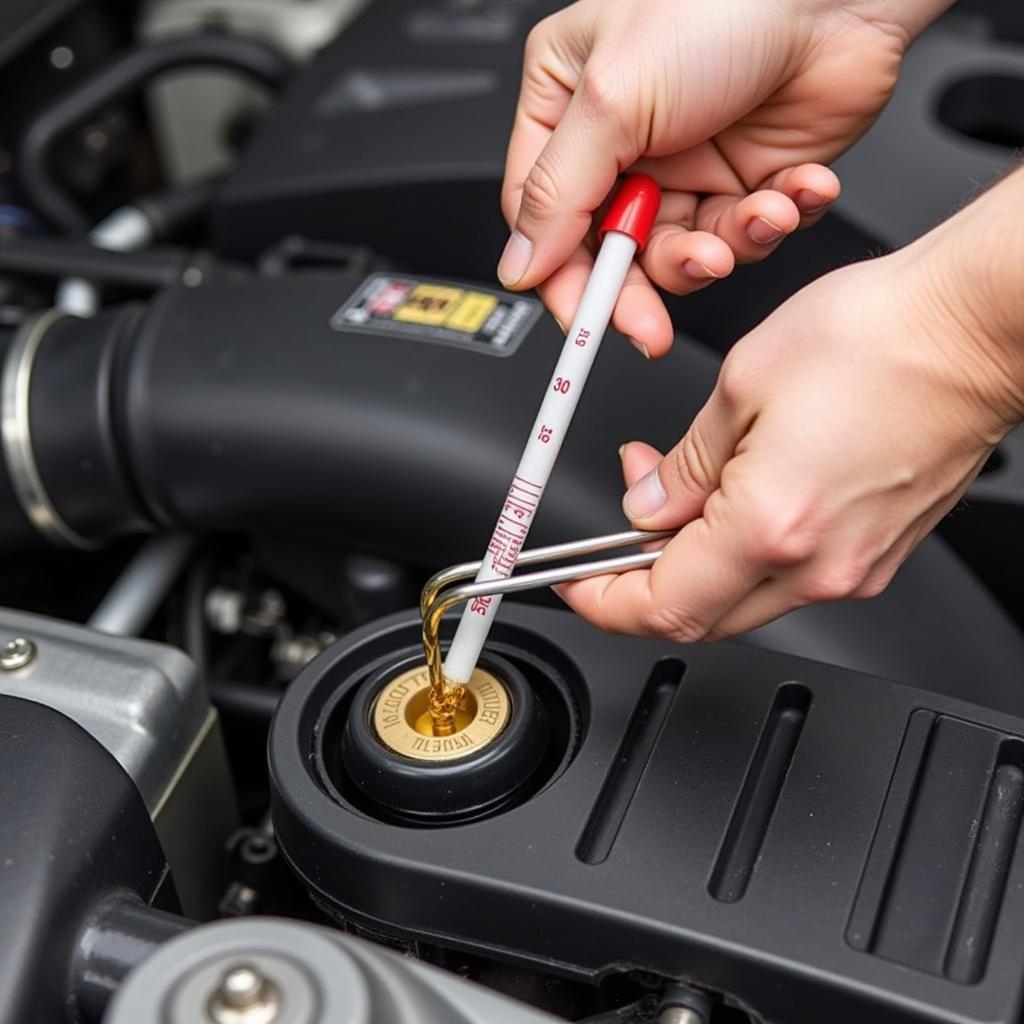Transmission fluid is vital for the health and longevity of your car’s transmission. Regular Car Maintenance Transmission Fluid checks and changes can prevent costly repairs down the road. This article dives deep into the importance of transmission fluid, how to check it, when to change it, and what type to use.
Similar to maintenance on car, maintaining transmission fluid is essential for a well-functioning vehicle. Ignoring this crucial aspect of car maintenance can lead to slipping gears, overheating, and ultimately, transmission failure. Understanding the role of transmission fluid is the first step to preventing these issues. Transmission fluid acts as a lubricant, reducing friction between the moving parts within the transmission. It also helps to cool the transmission and keep it operating at an optimal temperature. Furthermore, transmission fluid helps to transmit power from the engine to the wheels.
What are the signs of low or dirty transmission fluid? Common indicators include difficulty shifting gears, rough shifting, and a burning smell. You might also notice your car slipping out of gear or making whining or grinding noises. If you experience any of these symptoms, it’s crucial to check your transmission fluid immediately.
Checking Your Car Maintenance Transmission Fluid
Checking your transmission fluid is a relatively simple process. First, park your car on a level surface and ensure the engine is running and warm. Locate the transmission dipstick, which is usually marked with a bright handle and often has a symbol related to the transmission. Remove the dipstick, wipe it clean with a lint-free cloth, reinsert it fully, and then remove it again. Check the fluid level, which should be within the designated “full” or “add” marks on the dipstick. Also, pay attention to the fluid’s color and smell. Fresh transmission fluid is typically bright red and almost translucent. If it appears dark brown or black, or has a burnt odor, it’s likely time for a change.
 Checking Car Transmission Dipstick for Fluid Level and Condition
Checking Car Transmission Dipstick for Fluid Level and Condition
When to Change Your Car Maintenance Transmission Fluid
How often you should change your transmission fluid depends on several factors, including your car’s make and model, driving habits, and the type of transmission fluid used. Consult your car’s owner’s manual for the recommended service intervals. As a general guideline, most manufacturers suggest changing the transmission fluid every 30,000 to 60,000 miles for automatic transmissions. For manual transmissions, the interval can be longer, often between 60,000 and 100,000 miles. However, if you frequently drive in stop-and-go traffic, tow heavy loads, or drive in extreme temperatures, you may need to change your transmission fluid more frequently.
Just like with a car maintenance schedule 100 000 miles, understanding when to change transmission fluid prevents potential problems. Neglecting this vital maintenance can lead to expensive repairs and reduced vehicle lifespan. Regularly checking and changing your transmission fluid ensures optimal performance and extends the life of your transmission.
Choosing the Right Transmission Fluid
Selecting the correct transmission fluid is crucial. Using the wrong type can damage your transmission. Always refer to your car’s owner’s manual for the recommended type of fluid. Different types of transmissions require different types of fluid. Automatic transmissions typically use specialized fluids like Dexron or Mercon, while manual transmissions use gear oil. Using the incorrect fluid can lead to poor performance, damage to internal components, and even transmission failure.
What if My Car’s Maintenance Schedule Doesn’t Include Transmission Fluid Change?
Some newer vehicles, especially those with sealed transmissions, may not have a specified transmission fluid change interval in their maintenance schedule. This doesn’t necessarily mean the fluid never needs to be changed. It’s always best to consult a qualified mechanic for advice specific to your car model. They can assess the condition of your transmission fluid and recommend whether a change is necessary. Similar to situations where y car’s maintenance schedule doesn’t include transmission fluid change, consulting with a professional is the best course of action.
Why is Car Maintenance Transmission Fluid Important?
Transmission fluid keeps your car’s transmission running smoothly. It lubricates, cools, and helps transmit power.
How Do I Check My Transmission Fluid Level?
With the engine running and warm, locate the transmission dipstick, remove it, wipe it clean, reinsert it fully, and then remove it again to check the fluid level.
How Often Should I Change My Transmission Fluid?
Consult your owner’s manual for the recommended interval. Generally, it’s every 30,000 to 60,000 miles for automatic transmissions and 60,000 to 100,000 miles for manual transmissions.
Thinking about leasing? Consider lease car maintenance other for a comprehensive understanding of maintenance responsibilities.
Conclusion
Car maintenance transmission fluid is essential for a healthy and functioning vehicle. Regular checks and changes, along with using the correct fluid type, can prevent costly transmission repairs and ensure a smooth, reliable driving experience. By understanding the importance of car maintenance transmission fluid and following the guidelines in this article, you can keep your car running smoothly for years to come. If you have any further questions or concerns about your vehicle’s transmission, don’t hesitate to connect with the experts at AutoTipPro. Contact us at +1 (641) 206-8880 or visit our office at 500 N St Mary’s St, San Antonio, TX 78205, United States.





Leave a Reply